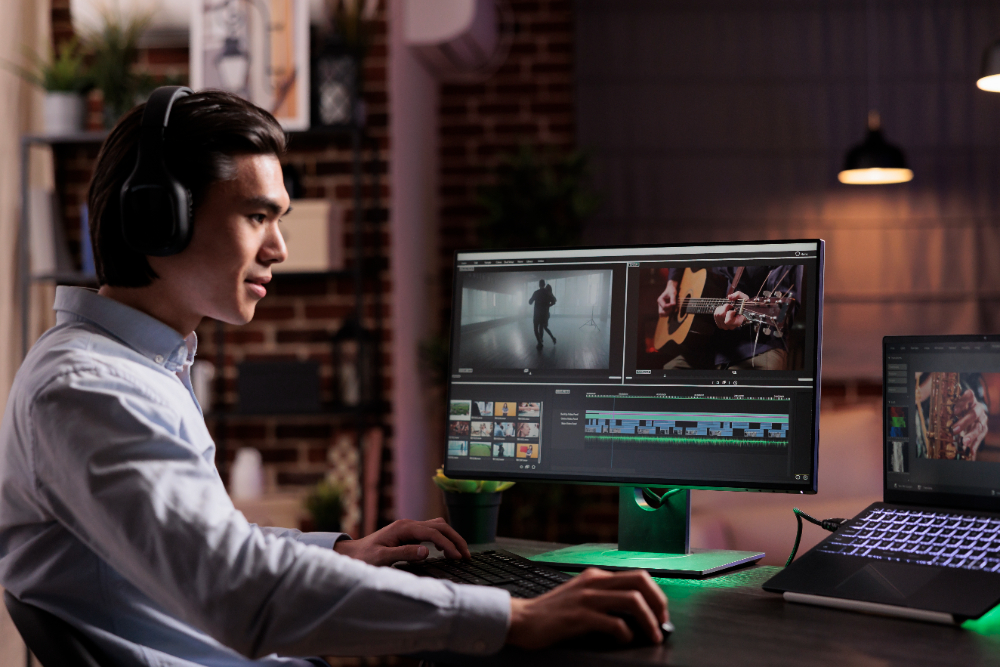The world of video editing is undergoing a transformative shift, thanks to the rapid advancements in artificial intelligence (AI). From automating repetitive tasks to offering innovative editing solutions, AI is revolutionizing how content creators produce and refine videos. As competition in content creation grows, integrating AI-driven tools into video editing workflows has become essential for both professionals and amateurs. In this blog, we’ll explore how AI is shaping video editing and how professional video editing services leverage this technology to deliver superior results.
How AI Enhances Video Editing
1. Automated Editing
AI tools can analyze hours of raw footage and automatically create cohesive edits. By detecting key moments, transitions, and patterns, AI saves hours of manual labor. This is particularly beneficial for creating trailers, highlights, or short promotional videos.
For example, AI-powered tools can identify and cut boring or irrelevant segments while emphasizing action-packed or emotionally engaging scenes.
2. Enhanced Precision
One of AI’s greatest strengths is its precision. AI tools can identify even the smallest details, like facial expressions or audio inconsistencies, and optimize them for a polished final product. This ensures videos are flawless and ready for professional use.
3. Smart Recommendations
AI tools analyze user preferences and project needs to offer personalized suggestions. Whether it’s recommending background music, effects, or color grading styles, AI takes the guesswork out of editing.
AI Features Transforming Video Editing
1. Speech-to-Text and Subtitling
AI-based speech recognition software can convert spoken words into text, making it easier to create subtitles and captions. This not only improves accessibility but also caters to audiences who prefer watching videos without sound.
2. Scene Detection
AI algorithms can detect scene changes, categorizing clips based on themes, colors, or actions. This makes it easier for editors to structure and arrange footage in a logical, impactful way.
3. Advanced Color Grading
AI tools offer automated color correction and grading based on industry standards or specific visual aesthetics. This saves time while maintaining consistency across videos.
4. Facial Recognition
Facial recognition technology identifies individuals in footage, making it easier to focus on key characters or blur sensitive information when needed.
AI’s Impact on Professional Video Editing Services
Professional video editing services are increasingly adopting AI-powered tools to improve efficiency and quality. These tools allow editors to focus on creative storytelling rather than time-consuming manual tasks.
For instance, AI enables services to:
- Deliver Faster Results: Automating repetitive tasks shortens project timelines.
- Ensure High Standards: AI minimizes errors, ensuring consistent and professional outcomes.
- Offer Competitive Pricing: Reduced manual labor translates to cost savings for clients.
Challenges of AI in Video Editing
While AI has brought significant advancements, it’s not without its challenges:
- Creativity Limitations: AI excels at automation but lacks the emotional and artistic intuition of human editors.
- Dependence on Data: AI relies on training data to function effectively, which may limit its scope in unique or unconventional projects.
- Learning Curve: Adopting AI tools requires time and effort to understand their full potential.
For this reason, professional video editing services combine AI’s efficiency with human creativity to achieve the best results.
Future Trends: AI in Video Editing
1. Real-Time Editing
AI advancements will soon enable real-time editing, allowing creators to make changes during live recordings. This will revolutionize live streaming and event coverage.
2. AI-Driven Storyboarding
Future AI tools will offer automatic storyboarding features, helping creators visualize and plan their content before filming begins.
3. Augmented Reality (AR) Integration
The combination of AI and AR will open new possibilities in immersive content creation, blending real-world footage with virtual elements seamlessly.
Why AI Is a Game-Changer
AI’s ability to handle complex editing tasks efficiently is a game-changer for the video editing industry. Whether it’s a small-scale YouTuber or a large production company, everyone can benefit from AI tools. For businesses, incorporating AI-powered professional video editing services can help create compelling content that drives engagement and builds brand identity.
Conclusion
AI is transforming video editing by simplifying workflows, enhancing quality, and unlocking new creative possibilities. While it has its limitations, combining AI with human expertise ensures the best outcomes. As content creation continues to evolve, embracing AI in video editing is no longer optional—it’s the key to staying ahead.
If you’re looking for top-tier professional video editing services that leverage AI to produce high-quality content, reach out to a trusted service provider today and elevate your storytelling.




